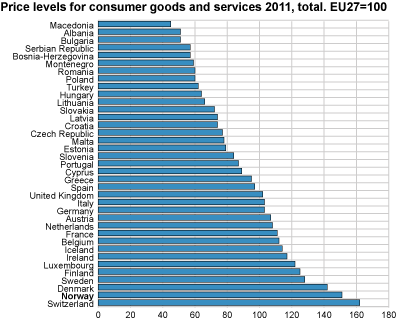Content
Published:
This is an archived release.
Wide spread in price levels across Europe
In a survey recently released by Eurostat, Switzerland and Norway came out as the two most expensive countries in Europe. The price level in the two EFTA countries was more than 50 per cent higher than the average price level in the EU.
The European Purchasing Power Parity Survey measures the price level across the countries of Europe. In 2011, Switzerland and Norway had the highest total price levels; 62 and 51 per cent above the average price level of the 27 EU member countries (EU27) respectively. This is partly due to strong national currencies against the euro, which makes both countries appear “more expensive” seen from abroad. The price level in Denmark was six per cent below, while Sweden and Finland had price levels about 16 per cent below the level in Norway. Macedonia, Bulgaria and Albania had the lowest price levels in Europe. In these countries the general price level is about one third of the Norwegian price level.
|
Food and
non-alcoholic beverages |
Alcoholic
beverages and tobacco |
Clothing | Footwear |
Restaurants
and hotels |
|||||||||||||||||||||||||||||||||||||||||||||||||||||||||||||||||||||||||||
|---|---|---|---|---|---|---|---|---|---|---|---|---|---|---|---|---|---|---|---|---|---|---|---|---|---|---|---|---|---|---|---|---|---|---|---|---|---|---|---|---|---|---|---|---|---|---|---|---|---|---|---|---|---|---|---|---|---|---|---|---|---|---|---|---|---|---|---|---|---|---|---|---|---|---|---|---|---|---|---|
| Norway | 164 | 250 | 134 | 141 | 184 | ||||||||||||||||||||||||||||||||||||||||||||||||||||||||||||||||||||||||||
| Switzerland | 156 | 124 | 138 | 138 | 157 | ||||||||||||||||||||||||||||||||||||||||||||||||||||||||||||||||||||||||||
| Denmark | 136 | 125 | 119 | 113 | 154 | ||||||||||||||||||||||||||||||||||||||||||||||||||||||||||||||||||||||||||
| Sweden | 120 | 145 | 133 | 127 | 147 | ||||||||||||||||||||||||||||||||||||||||||||||||||||||||||||||||||||||||||
| Italy | 106 | 103 | 99 | 112 | 108 | ||||||||||||||||||||||||||||||||||||||||||||||||||||||||||||||||||||||||||
| United Kingdom | 103 | 147 | 97 | 82 | 105 | ||||||||||||||||||||||||||||||||||||||||||||||||||||||||||||||||||||||||||
| France | 108 | 109 | 104 | 98 | 104 | ||||||||||||||||||||||||||||||||||||||||||||||||||||||||||||||||||||||||||
| Germany | 110 | 97 | 103 | 105 | 103 | ||||||||||||||||||||||||||||||||||||||||||||||||||||||||||||||||||||||||||
| Greece | 103 | 92 | 103 | 108 | 98 | ||||||||||||||||||||||||||||||||||||||||||||||||||||||||||||||||||||||||||
| Spain | 93 | 83 | 88 | 102 | 94 | ||||||||||||||||||||||||||||||||||||||||||||||||||||||||||||||||||||||||||
| Turkey | 80 | 92 | 65 | 65 | 71 | ||||||||||||||||||||||||||||||||||||||||||||||||||||||||||||||||||||||||||
| Source: Eurostat. |
Norway most expensive for most types of goods and services
Norway is the most expensive European country for several product groups in the survey. The Norwegian price level for “Alcoholic beverages and tobacco” was two and a half times the average of EU27. For “Restaurants and Hotels” the Norwegian price level was 84 per cent higher, while for “Food and non-alcoholic beverages” the price level was 64 per cent above the EU27 average. The Norwegian prices for “Clothing” and “Footwear” were 34 and 41 per cent higher than EU27, respectively.
Balkan countries cheapest for restaurant and hotel services
In 2011, Macedonia, Albania and Bulgaria had Europe’s lowest prices for restaurant and hotel services. The price level for these services in the Western Balkan countries was about a quarter of the Norwegian level. Among Norwegians’ most popular holiday destinations, Turkey has the most friendly price level, about 60 per cent lower than in Norway. The price level in Spain and Greece was about 50 per cent lower, while the price level in Germany, France, United Kingdom and Italy was about 40 per cent lower than in Norway. Finally, the price level for restaurant and hotel services in Sweden and Denmark was about 20 per cent lower than in Norway.
Highest price dispersion for alcoholic beverages and tobacco
The survey results also show the price dispersion between the countries (variation coefficients). Alcoholic beverages and tobacco is the product group with the largest price level differences. The high degree of price dispersion is to a large extent due to differences in taxation across countries. Restaurant and hotel services also have a high price dispersion. One reason for this is that the price level of services tends to correlate with countries` widely different relative income levels.
|
The price survey covers more than 2 400 consumer goods and services across 37 European countries; The 27 EU member states The acceding state Croatia The four candidate countries; Montenegro, Serbia, Macedonia and Turkey Three EFTA countries; Norway, Iceland and Switzerland Two other countries; Albania, Bosnia-Herzegovina The results of the survey are expressed in price level indices, which provide a comparison of a country’s price level with respect to the European Union average; if the price level index for a country is 120, this means that the price level for this country is 20 per cent above the average of the 27 EU member states. Changes in currency exchange rates affect the price level from one year to another. The price level indices show only relative differences in price levels between countries and do not indicate the actual purchasing power of an average income in each country. The total price level indices include groups of goods and services in addition to those published in this article. |
Read more in Eurostat’s ” Statistics in Focus ”.
Tables:
The statistics is now published as Comparison of price levels in Europe.
Contact
-
Statistics Norway's Information Centre
E-mail: informasjon@ssb.no
tel.: (+47) 21 09 46 42

